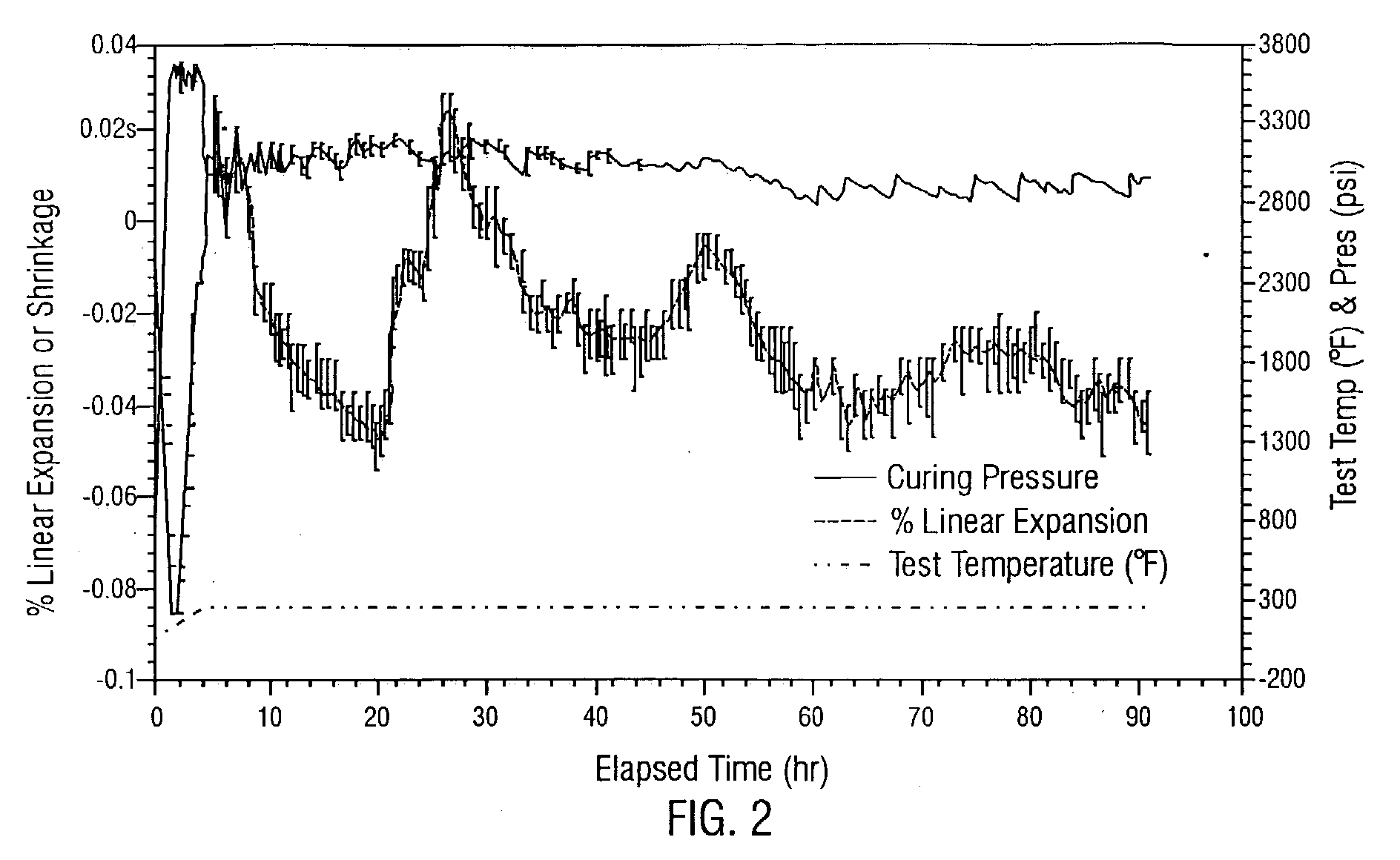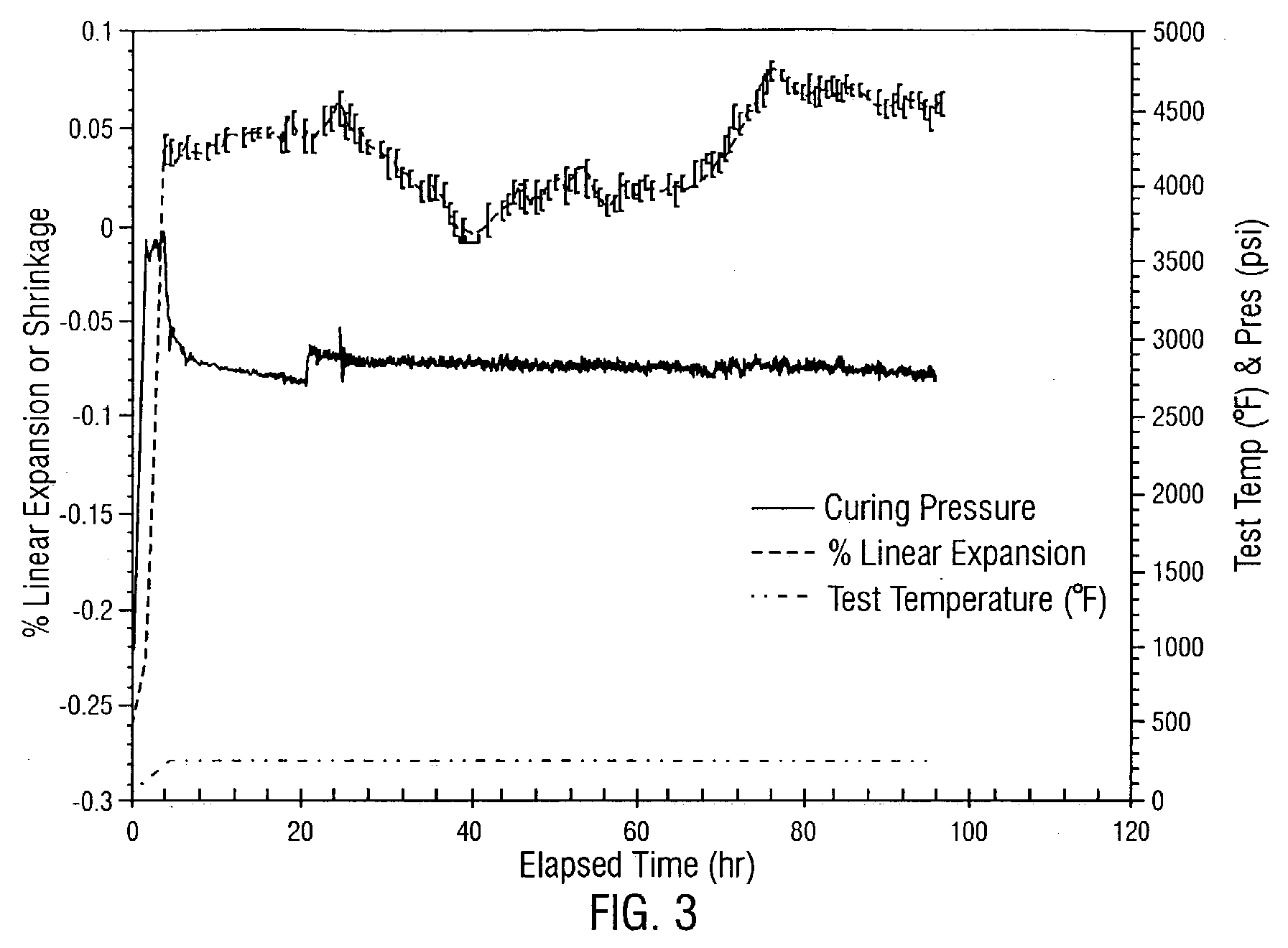Polymer shell encapsulated gas as a cement expansion additive
a polymer shell and cement expansion technology, applied in the direction of ceramicware, sealing/packing, borehole/well accessories, etc., can solve the problems of reducing the service life of the well, so as to reduce or minimize the occurrence of contraction, the effect of reducing or preventing the gas escap
- Summary
- Abstract
- Description
- Claims
- Application Information
AI Technical Summary
Benefits of technology
Problems solved by technology
Method used
Image
Examples
example 2
Assay Methods
[0040] Thickening time was determined by the use of an API Pressurized Consistometer. The Pressurized Consistometer is a laboratory instrument designed to determine how long the slurry will stay fluid at simulate downhole well temperatures up to 600.degree. F. (316.degree. C.) and simulated pressure up to 40,000 PSI (276 MPa). Hydrocarbon oil such as mineral oil is used to pressurize the test cell. The pressurized Consistometer consists of a rotating cylindrical slurry container equipped with a stationary paddle assembly that is engaged with a potentiometer mechanism. The slurry cup with the slurry is placed inside the test cell. At the bottom of the test cell is a rotary table that revolve at a speed of 150 rpm. The bottom cover of the slurry cup is fitted with two rolled pins. The rolled pins will engage to the rotary table. The cylindrical slurry cup will turn as the rotary table rotates. During the assays, the cement viscosity will increase with time at simulated do...
example 3
Evaluation of Changes in Thickening Time from Addition of EXPANCEL
[0043] Type H cement compositions were prepared containing or lacking EXPANCEL material. All samples contained 0.2 weight percent R-3 (based on weight of cement). The compositions had a density of 16.2 pounds per gallon, and a yield of 1.09 cubic feet per sack (94 pounds of cement). The thickening time was determined at a test temperature of 167.degree. F. (75.degree. C.) and pressure of 6500 psi. Cement typically encounters this temperature and higher temperature in down hole oil and gas wells.
1 Thickening time Sample Water (gal / sk) EXPANCEL (hr:min) 1 4.56 None 4:57 2 4.48 1 wt % 461Wu-40 4:54 3 4.48 1 wt % 820Wu-40 4:43
[0044] These results show that the addition of EXPANCEL to a cement composition did not have a significant effect on the thickening time.
example 4
Evaluation of Changes in Thickening Time from Addition of EXPANCEL
[0045] Type H cement compositions were prepared containing or lacking EXPANCEL material. All samples contained 0.35 weight percent R-3 (based on weight of cement). The compositions had a density of 16.2 pounds per gallon, and a yield of 1.09 cubic feet per sack (94 pounds of cement). The thickening time was determined at a test temperature of 201.degree. F. (94.degree. C.) and pressure of 7900 psi.
2 Thickening time Sample Water (gal / sk) EXPANCEL (hr:min) 4 4.45 None 5:36 5 4.48 1 wt % 461Wu-40 5:34 6 4.48 1 wt % 820Wu-40 5:45 7 4.32 3 wt % 820Wu-40 5:20 8 4.48 1 wt % 053Wu-40 6:23
[0046] As observed in the previous example, the addition of EXPANCEL did not significantly change the thickening time of the cement. The thickening time was somewhat longer at the higher temperature of this example: 201.degree. F. (94.degree. C.) as compared to 167.degree. F. (75.degree. C.).
PUM
| Property | Measurement | Unit |
|---|---|---|
| Angle | aaaaa | aaaaa |
| Angle | aaaaa | aaaaa |
| Angle | aaaaa | aaaaa |
Abstract
Description
Claims
Application Information
 Login to View More
Login to View More - R&D
- Intellectual Property
- Life Sciences
- Materials
- Tech Scout
- Unparalleled Data Quality
- Higher Quality Content
- 60% Fewer Hallucinations
Browse by: Latest US Patents, China's latest patents, Technical Efficacy Thesaurus, Application Domain, Technology Topic, Popular Technical Reports.
© 2025 PatSnap. All rights reserved.Legal|Privacy policy|Modern Slavery Act Transparency Statement|Sitemap|About US| Contact US: help@patsnap.com



